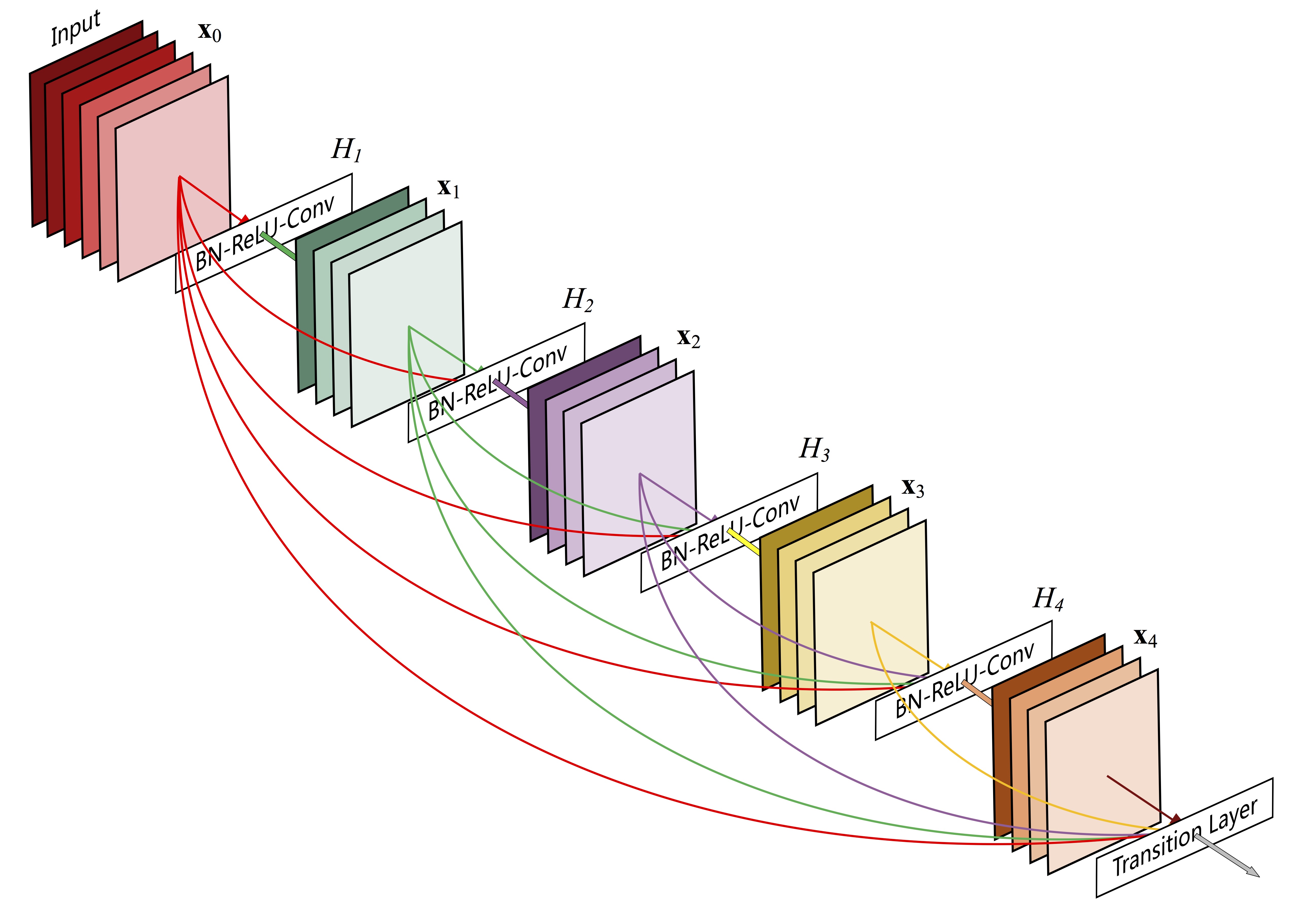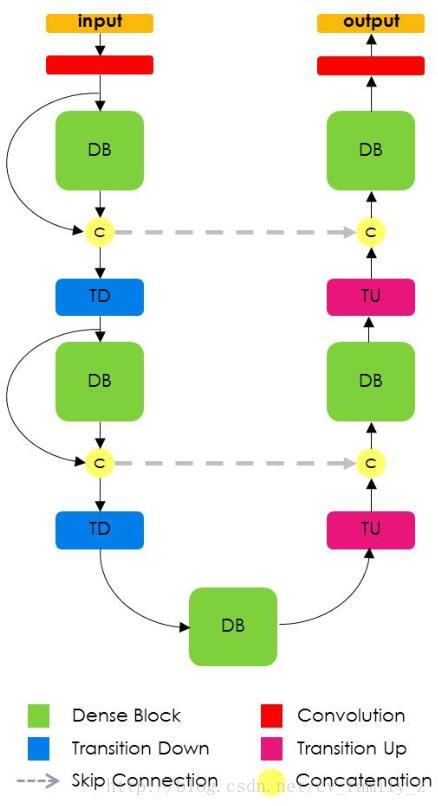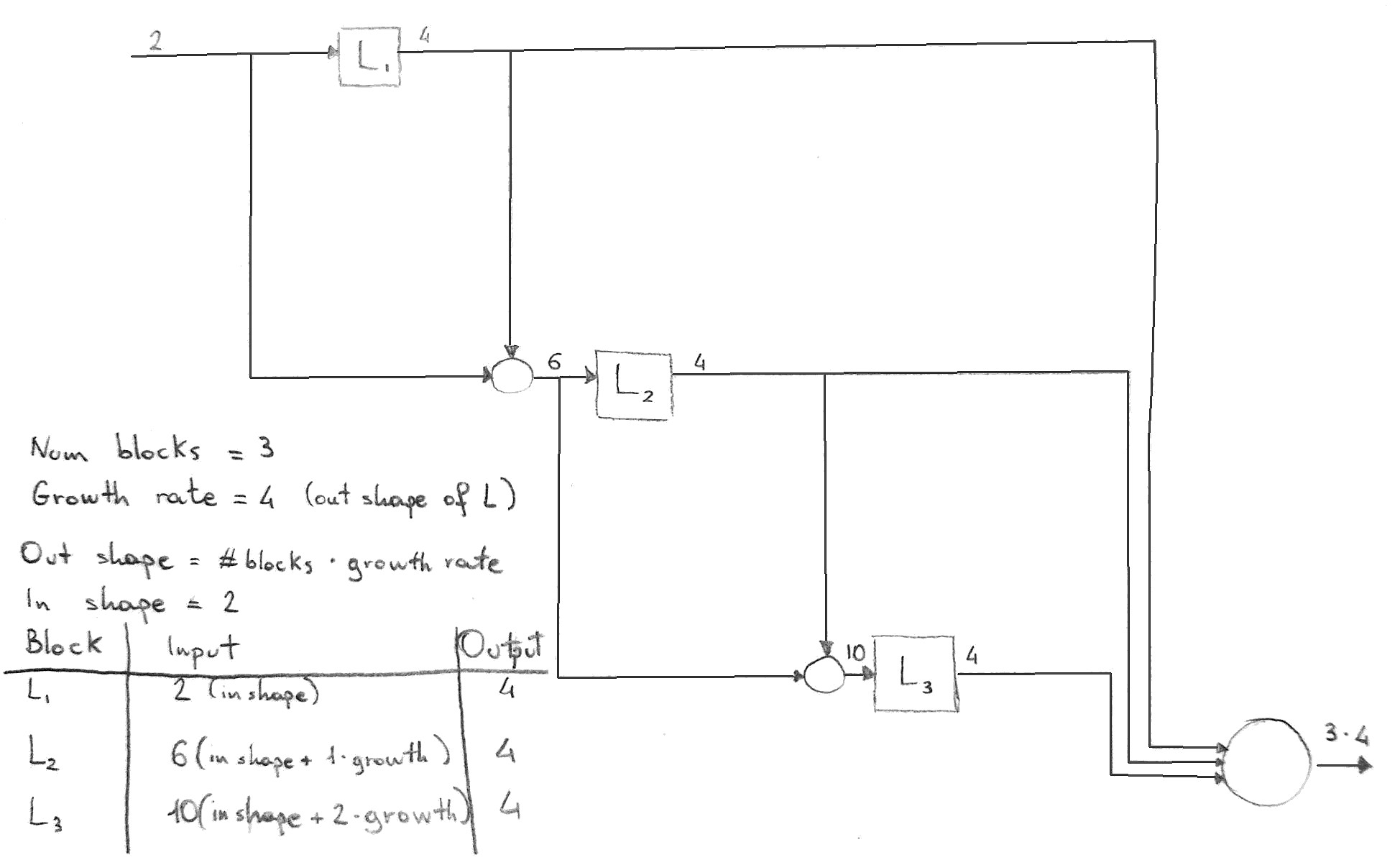A PyTorch implementation of the DenseNet and FCDenseNet architectures from the papers:
- Densely Connected Convolutional Networks by Gao Huang, Zhuang Liu, Laurens van der Maaten, Kilian Q. Weinberger
- The One Hundred Layers Tiramisu: Fully Convolutional DenseNets for Semantic Segmentation by Simon Jégou, Michal Drozdzal, David Vazquez, Adriana Romero, Yoshua Bengio
The goal of this package is to provide a nice and simple object-oriented implementation of the two architectures. The individual submodules are cleanly separated into self-contained blocks, that come with documentation and typings, and that are therefore easy to import and reuse.
The minimal requirements for the library are Python 3.6+ and PyTorch 1.1+.
A conda environment as such is recommended:
conda create --name densenet python=3.7
conda install --name densenet -c pytorch pytorch torchvisionWithin the correct environment, install the package from GitHub:
conda activate densenet
pip install git+https://github.com/baldassarreFe/pytorch-densenet-tiramisuFor training and development, do:
conda env create -f conda.yaml
conda activate densenet
git clone https://github.com/baldassarreFe/pytorch-densenet-tiramisu
pip install --editable pytorch-densenet-tiramisu
pytest pytorch-densenet-tiramisuEither load a predefined network:
from dense import FCDenseNet103
from dense.utils import count_parameters, count_conv2d
net = FCDenseNet103()
print('Layers:', count_conv2d(net))
print('Parameters:', count_parameters(net))Layers: 103
Parameters: 17236944
Or use the modules for your custom architecture:
from torch.nn import Sequential
from dense import DenseLayer, DenseBlock
class AwesomeModule(Sequential):
def __init__(self, in_channels, out_channels):
super(AwesomeModule, self).__init__()
self.block = DenseBlock(in_channels, growth_rate=4, num_layers=2,
concat_input=True, dense_layer_params={'dropout': 0.2})
self.layer = DenseLayer(self.block.out_channels, out_channels, bottleneck_ratio=2)
awesome = AwesomeModule(10, 4)
print(awesome)AwesomeModule(
(block): DenseBlock(10, 2*4+10=18)(
(layer_0): DenseLayer(10, 4)(
(norm): BatchNorm2d(10, eps=1e-05, momentum=0.1, affine=True)
(relu): ReLU(inplace)
(conv): Conv2d(10, 4, kernel_size=(3, 3), stride=(1, 1), padding=(1, 1), bias=False)
(drop): Dropout2d(p=0.2, inplace)
)
(layer_1): DenseLayer(14, 4)(
(norm): BatchNorm2d(14, eps=1e-05, momentum=0.1, affine=True)
(relu): ReLU(inplace)
(conv): Conv2d(14, 4, kernel_size=(3, 3), stride=(1, 1), padding=(1, 1), bias=False)
(drop): Dropout2d(p=0.2, inplace)
)
)
(layer): DenseLayer(18, 4)(
(norm): BatchNorm2d(18, eps=1e-05, momentum=0.1, affine=True)
(relu): ReLU(inplace)
(bottleneck): Bottleneck(18, 8)(
(conv): Conv2d(18, 8, kernel_size=(1, 1), stride=(1, 1), bias=False)
(norm): BatchNorm2d(8, eps=1e-05, momentum=0.1, affine=True)
(relu): ReLU(inplace)
)
(conv): Conv2d(8, 4, kernel_size=(3, 3), stride=(1, 1), padding=(1, 1), bias=False)
)
)
DenseNet is a network architecture where each layer is directly connected to every other layer in a feed-forward fashion (within each dense block). For each layer, the feature maps of all preceding layers are treated as separate inputs whereas its own feature maps are passed on as inputs to all subsequent layers.
The building block of DenseNet is a densely connected block, that leverages skip connections between the internal layers to facilitate the flow of information and gradients:
Several blocks can be arranged in a sequence, interleaved by layers that scale down the size of the feature maps, with the aim of performing image classification.
FCNs are built from a downsampling path, an upsampling path and skip connections. Skip connections help the upsampling path recover spatially detailed information from the downsampling path, by reusing features maps. The goal of our model is to further exploit the feature reuse by extending the more sophisticated DenseNet architecture, while avoiding the feature explosion at the upsampling path of the network.
The implementation of DenseNet and its components references the Torch implementation by the original original authors, and the PyTorch implementation from torchvision, with some differences that illustrated and justified below.
Equation 2 from the paper shows that the output of a Dense Layer does not comprise the concatenation of its input,
therefore a Dense Layer can be implemented as normal torch.nn.Sequential module.
In the context of a DenseNet, it's up to the containing Dense Block to take care of concatenating
the input and the output of its Dense Layers.
The l-th layer receives the feature-maps of all preceding layers,
x_0, ..., x_{l−1}, as input:
x_l = H_l([x0, x1, ..., x_{l−1}])
where
[x0, x1, ..., x_{l−1}]refers to the concatenation of the feature-maps produced in layers0, ..., l−1
An optional bottleneck block, based on a 1x1 convolution, can be added to reduce the number of parameters and the memory consumption of a forward/backward pass:
It has been noted that a 1×1 convolution can be introduced as bottleneck layer before each 3×3 convolution to reduce the number of input feature-maps, and thus to improve computational efficiency. We find this design especially effective for DenseNet and we refer to our network with such a bottleneck layer, i.e. to the BN-ReLU-Conv(1×1)-BN-ReLU-Conv(3×3) version of Hl, as DenseNet-B. In our experiments, we let each 1×1 convolution produce 4k feature-maps.
With the addition of such bottleneck and an optional dropout layer, a Dense Layer has the following stucture:
- Batch Normalization
- ReLU
- (Bottleneck)
- 1x1 Convolution (4k filters)
- Batch Normalization
- ReLU
- 3x3 Convolution (k filters)
- (Dropout)
The following sketch illustrates the architecture of a Dense Block as implemented in this project, note how in this case the block input was not concatenated to form the block output:
If each function
H_lproduceskfeature maps, it follows that thel-thlayer hask_0 + k * (l−1)input feature-maps, wherek_0is the number of channels in the input layer. [...] We refer to the hyperparameterkas the growth rate of the network.
A Dense Block consists of several Dense Layers (possibly with Bottleneck and Dropout), all having the same output shape:
- The first DenseLayer is fed with the block input
- Each subsequent Dense Layer is fed with the concatenation of the input and the output of the previous Dense Layer (on the channel axis)
- The output of the block is the concatenation of the outputs of every Dense Layer, and optionally the block input
Depending on whether the block input is concatenated or not with the outputs of the layers,
the block output will have a channel depth of either growth_rate * num_layers or growth_rate * num_layers + in_channels
Transition layers are placed between each pair of Dense Blocks, with the purpose of halving the width and height of the feature maps and optionally reducing the number of channels.
We refer to layers between blocks as transition layers, which do convolution and pooling. The transition layers used in our experiments consist of a batch normalization layer and an 1×1 convolutional layer followed by a 2×2 average pooling layer
To further improve model compactness, we can reduce the number of feature-maps at transition layers. If a dense block contains m feature-maps, we let the following transition layer generate
[θm]output feature maps, where0<θ≤1is referred to as the compression factor
A Transition block can be implemented with a torch.nn.Sequential module composed of:
- Batch Normalization
- ReLU
- 1x1 Convolution (θm filters)
- 2x2 Average Pooling
The implementation of FCDenseNet and its components references the Lasagne implementation by the original original authors, and the PyTorch notebooks by bfortuner, with some differences that illustrated and justified below.
Dense block layers are composed of BN, followed by ReLU, a 3 × 3 'same' convolution (no resolution loss) and dropout with probability p = 0.2. The growth rate of the layer is set to k = 16
Since the upsampling path increases the feature maps spatial resolution, the linear growth in the number of features would be too memory demanding, especially for the full resolution features in the pre-softmax layer. In order to overcome this limitation, the input of a dense block is not concatenated with its output
FCDenseNet can fully reuse the Dense Block implemented for DenseNet, considering that:
- the FCDenseNet paper does not make use of Bottleneck layers in tits Dense Blocks
- In the downward path, each Dense Block concatenates the outputs of its Dense Layers to the block input
(Output channels:
growth_rate * num_layers + in_channels) - In the upward path, each Dense Block only concatenates the outputs, dropping the block input
(Output channels:
growth_rate * num_layers)
A transition down is introduced to reduce the spatial dimensionality of the feature maps. Such transformation is composed of a 1×1 convolution (which conserves the number of feature maps) followed by a 2 × 2 pooling operation.
A Transition Down block is implemented with a torch.nn.Sequential module:
- Batch Normalization
- ReLU
- 1x1 Convolution (preserving the number of channels)
- (Dropout)
- 2x2 Max Pooling
Differences from the Transition layer in DenseNet:
- TransitionDown blocks use Max Pooling instead of Average Pooling
- TransitionDown blocks might include a Dropout layer
- TransitionDown blocks do not change the number of channels, i.e. no "compression" is performed,
however the implementation accepts a
compressionparameter that behaves similarly to DenseNet
The layer placed at the bottom part of the network is a regular Dense Block, but it's worth noting that:
- in the paper it is indicated as a "bottleneck" block, but the FCDenseNet class uses "middle" as a field name to avoid confusion with the optional Bottleneck of Dense Layers
- in figure 1 of the paper (reported above), it appears that this Dense Block does not concatenate its input to the output, but the channel count in table 2 only results correct if such concatenation performed, which is also what this implementation uses
In the upward path, the feature volume produced by a Dense Block is scaled up with a transposed convolution and then concatenated with the feature volume produced by the corresponding Dense Block in the downward path.
Due to the pooling operations happening in the Transition Down layers, it is possible that the feature maps
to be concatenated do not perfectly match in width and height. If this happens, the feature maps are centrally
aligned and then the non-overlapping areas are cropped out. This operation is implemented separately in the
CenterCropConcat layer and can be reused in similar situations.
If you find a bug, or would like to see a feature implemented, feel free to create an issue.
Of course, help and contributions are welcome!
This is the general workflow:
- fork this repository from GitHub
- clone your fork locally
- set up the conda environment
- pip-install the package in 'development' mode
- commit your changes to a feature branch
- push to your fork
- open a pull request!
git clone https://github.com/<your username>/pytorch-densenet-tiramisu
cd pytorch-densenet-tiramisu
conda env create --file densenet.yml
source activate densenet
pip install -e .
git checkout -b <feature branch>
...
<develop, test, commit, repeat>
...
git push --set-upstream origin <feature branch>The code for this package was originally inspired by the following sources:
- the author's implementation of DenseNet in Torch
- the torchvision implementation of DenseNet in PyTorch
- the author's implementation of FCDenseNet in Lasagne
- bfortuner's notebooks on FCDenseNet in PyTorch
The package is provided as is, under the conditions of the MIT license.



